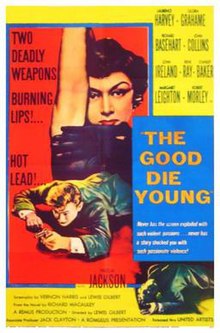| The Good Die Young | |
|---|---|

US 1955 cinema poster
| |
| Directed by | Lewis Gilbert |
| Produced by | John Woolf |
| Screenplay by | Vernon Harris Lewis Gilbert |
| Based on | The Good Die Young by Richard Macauley |
| Starring | Laurence Harvey Gloria Grahame Richard Basehart Joan Collins John Ireland Rene Ray Stanley Baker Margaret Leighton |
| Music by | Georges Auric |
| Cinematography | Jack Asher |
| Edited by | Ralph Kemplen |
Production
company | |
| Distributed by | IFD (UK) United Artists (US) |
Release dates
|
|
Running time
| 94 min. |
| Country | United Kingdom |
| Language | English |
The Good Die Young (1954) is acrime thriller film made in the United Kingdom by Remus Films, featuring a number of American characters. It was directed by Lewis Gilbert. The screenplay was based on the book of the same name written by Richard Macaulay.
Contents
[hide]- 1Plot
- 2Principal cast
- 3Production
- 4Notes
- 5External links
Plot[edit]
The film opens with four men in a car, apparently about to commit a serious crime. How each of the previously law-abiding men came to be in this position is then explored.Mike (Stanley Baker) is an ageing boxer, in love with his wife (Rene Ray) but injured and unable to find a job. Joe (Richard Basehart) is an out-of-work clerk who needs to fly to the United States with his young wife (Joan Collins) to escape her clinging and unstable mother (Freda Jackson). Eddie (John Ireland) is an AWOL American airman with an unfaithful actress wife (Gloria Grahame). The last man, 'Rave' Ravenscourt (Laurence Harvey), is a 'gentleman' sponger and a scoundrel with gambling debts and the unscrupulous leader who lures the other three. The film reaches a bloody climax at Heathrow Airport.The Good Die Young is a prime example of the perils of bracketing all mainstream 1950s British films as 'staid' or 'repressed'. Director and co-screenwriter Lewis Gilbert, fresh from Cosh Boy (1953), creates a grimfilm noir in a London that is just as menacing as that of Night and the City(UK/US, d. Jules Dassin, 1950). The mood of impending doom is set byGeorge Auric's plangent theme music, and in place of the standard issue trilby-hatted Detective Inspector, an uncredited narrator introduces the quartet of main characters. Any early '50s filmgoer would easily guess that a Mk. VII Jaguar cruising through nighttime Chelsea would be the prelude to a crime, but the fascination of The Good Die Young is in character rather than the actual heist.The film details how three 'honest men' - ex GI Richard Baseheart, cuckolded USAF Sergeant John Ireland and crippled ex-boxer Stanley Baker make the very bad career decision to join forces with decadent playboy Miles 'Rave' Ravescourt and carry out a bullion robbery.Baseheart and Ireland, both cast in order to gain the film US distribution, give solid workmanlike performances, as do Gloria Grahame and Joan Collins. However, the most eye-catching performances are from theGrand Guignol of Freda Jackson as Baseheart's mother-in-law; Stanley Baker, who succeeds by playing his role completely straight; and from a young Laurence Harvey as Rave, who, in addition to boasting a great name, gave Harvey his first opportunity to create a notable screen villain. As the narrative progresses, his smile becomes yet more lizard-like, while his pompadour grows to ever more surreal heights.lthough the budgetary limitations are occasionally visible, the film's strongest moments revolve around its sense of claustrophobia, fromBaker facing a future of penny-pinching despair to the confrontation between Rave and his father in a gentleman's club. Here, the narrative even attempts to suggest a parallel between Rave's war heroism and his psychopathic tendencies, although admittedly the screenplay skirts around the issue by insinuating that his war record is largely fictitious. But it is still an unequalled moment in 1950s British film, as is Robert Morley's fear and loathing of his screen son in an era of amiable screen patriarchs. The film's conclusion, with all four gang members dead, the money hidden in a graveyard and the narrator giving the bleak coda, is redolent less of Edgar Lustgarten than of the future Hammer Horrors.
· v· t· eFilms directed by Lewis Gilbert· The Good Die Young (1954)



No comments:
Post a Comment